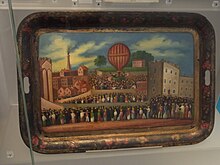Japan

Japanning is a kind of finish that was created as a European imitation of Asian lacquers . It was first used for furniture, but later it was often used for small metal objects. The word originated in the 17th century. American work is more commonly referred to as toleware .
Manufacturing
Although often referred to as lacquer, it differs from real East Asian lacquer, which is made by coating objects with a preparation based on the dried sap of the lacquer tree (Toxicodendron vernicifluum), which was not available in Europe.
Japanning is mostly a heavy black “lacquer”, almost like enamel paint . Black is widespread and Japanese is often considered synonymous with Black Japanese. European engineering uses resin-based varnishes , similar to shellac , which are applied in heat-dried layers and then polished to create a smooth, shiny finish. It can also come in red, green, and blue.
Originally from India , China and Japan as a decorative coating for pottery , it reached Europe in the 17th century. In the late 17th century, high European demand and rumors that higher quality pieces were not being exported prompted production to start in Italy . In its traditional form, gold designs and imagery were used to contrast with the black base color.
Development in Europe
As the demand for anything that was painted increased, so did the Italian technique of imitating Asian paints. Japanese art developed in England , France , Italy and the Netherlands in the 17th century . The technique has been described in manuals such as Stalker and Parker's Treatise on Japanning and Varnishing, published in Oxford in 1688 . Colonial Boston was a major center of Japanese trade in America, where at least a dozen carpenters made it their specialties. In England, decoupage , the art of applying paper cutouts to other objects, became very popular, especially the botanically inspired works of Mary Delany .
Wolverhampton and Bilston
Wolverhampton and Bilston were important centers for the manufacture of painted goods. Trade directories for 1818 list 20 Japanese firms in Wolverhampton and 15 in Bilston. According to Samuel Timmins' book Birmingham and the Midland Hardware District, published in 1866, Wolverhampton and Bilston had 2000 employees in the Japanese and tinplate industries at the time. Japanese firms ranged in size from small family workshops, often adjacent to the owner's house, to a few large factories with over 250 employees. In the larger workshops, tinplate and papier-mâché items and the Japanning process took place under one roof, while in the smaller workshops only one or two of the trades were carried out, usually tinplate work and Japanning.
At the height of its popularity, richly decorated lacquered dishes could be seen in every bourgeois home, but this began to change from the middle of the 19th century. In the 1880s, the Japanese and tinplate industries were in decline. This was partly due to changes in fashion and taste, and partly due to the development of electroplating . In response, manufacturers of painted goods have focused on more functional items, including painted cash boxes. Many turned to other professions, including enamelling, electroplating, and making copper and brass charcoal containers, fire grilles, and kettles. By the 1920s, the West Midlands decorative lacquer ware industry had largely died out. Many companies began supplying painted metal to the newly formed bicycle and automotive industries, and some even made their own bicycles. The most successful was John Marston, whose Japanese factory began making bicycles in 1887. The bicycle manufacturing part of the business quickly became more successful than the manufacture of decorative lacquered goods. Marston's wife found that the gold on the black-painted bikes looked like sunbeams and the bikes were labeled Sunbeam and their factory was called Sunbeamland .
Metal with Japanese
Hardware was painted black for decorative reasons. It was also used to make it rust free, suitable for carrying water. In Pontypool and Usk , a significant industry has developed, imminent in the region tinplate was produced. Japanese goods were also made in Bilston in 1719 and later elsewhere in the area.
Applications
The technique was also developed to protect metal items such as sewing machines , hand planes , construction supplies, and water meters manufactured in North America prior to the mid-1930s . It was later used as an insulating film on transformer sheets. It was also used as a substrate for the photographic color process.
bibliography
- Emily Eerdmans: The International Court Style: William & Mary and Queen Anne, 1689-1714: The Call of the Orient . In: Classic English Design and Antiques: Period Styles and Furniture: The Hyde Park Antiques Collection . Rizzoli International Publications, New York 2006, ISBN 978-0-8478-2863-0 , pp. 22-25.
Web links
- Japaning on the Wolverhampton History and Heritage website
Individual evidence
- ↑ MB Rowlands, Masters and Men in the West Midlands metalware trades before the industrial revolution (Manchester University Press 1975), 134-136 etc.


